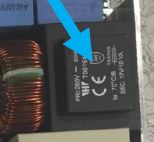Good morning Jeroen (naamgenoot),
Yes, such devices are here (Portugal) mandatory in TT, earth pin inhouse only and/or various earth pins in and around the house.
For the grid side (input inverters) we have the Hager P120 (3x) and the P150, these should keep the phases and neutral on 255V when there is a lightning strike.
Under normal conditions and the voltage goes over the 255V nothing happens, only with a strike.
On the output of the inverters we have the Hager SPN465R, what will keep the neutral on 255V and the phases on 275V.
This as not only a strike can come through the grid but can also come from PV panels, outside lamps, buried cabling, even through the earth pin, etc.
The OBO V20-C limits the phases at 280V and the neutral at 255V.
There are many brands for that, but these do not solve the overvoltage we experience.
Then, when you set in VE, the input voltages as you have, indeed it will go to inverter control, however, the control board still gets the grid voltage (and also measures), if it comes above the 265-270-isch Volt than the inverter trips, as I experienced, see above.
For your insertion to the grid, the grid is the grid, you must raise the voltage (normally plus 3-5V) to be able to insert to the grid, just set the maximum voltage to 258-260V instead of 255V, check how that goes.
I do not insert to the grid, I have my own micro-grid at 230V, at full PV power on the output, the output of the inverters are still 230V, always, that output the main inverters regulate perfect, during full PV and starting heavy equipment we see fluctuations of maximum 3V only, very good.
Therefore I say that the people with ESS, DESS and direct grid connected have now big issues due to the high grid voltage, damaging many household appliances.
And even, people like me, hanging on the grid for backup only, any inverter will trip above 265-270-isch Volt anyway as it primarily feeds the control board.
Only, the real off-grid inverters run on their secondary power supply from the battery.
Thats, why we want to place a simple relais in between the grid and the inverters, so it keeps on running when very high voltages occur.
Maybe only once or twice a year now, but it does…
Regards, Jeroen.







